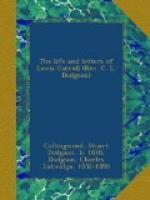On August 21st he received a long letter from his father, full of excellent advice on the importance to a young man of saving money:—
I will just sketch for you [writes the Archdeacon] a supposed case, applicable to your own circumstances, of a young man of twenty-three, making up his mind to work for ten years, and living to do it, on an Income enabling him to save L150 a year—supposing him to appropriate it thus:—
L s. d.
Invested at 4 per cent. ... ... 100 0 0
Life Insurance of L1,500 ...
29 15 0
Books, besides those bought in
ordinary course ... ... ... 20 5
0
_____________
L150 0
0
Suppose him at the end of the ten
years to get a Living
enabling him to settle, what will be the result
of his
savings:—
1. A nest egg of L1,220
ready money, for furnishing and
other expenses.
2. A sum of L1,500 secured
at his death on payment of a
very much smaller annual Premium than if
he had then
begun to insure it.
3. A useful
Library, worth more than L200, besides the
books bought out of his current
Income during the period....
The picture on the opposite page is one of Mr. Dodgson’s illustrations in Misch-Masch, a periodical of the nature of The Rectory Umbrella, except that it contained printed stories and poems by the editor, cut out of the various newspapers to which he had contributed them. Of the comic papers of that day Punch, of course, held the foremost place, but it was not without rivals; there was a certain paper called Diogenes, then very near its end, which imitated Punch’s style, and in 1853 the proprietor of The Illustrated News, at that time one of the most opulent publishers in London, started The Comic Times. A capable editor was found in Edmund Yates; “Phiz” and other well-known artists and writers joined the staff, and 100,000 copies of the first number were printed.




